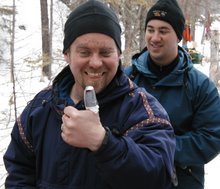Every voice teacher uses imagery and metaphor to teach basic vocal concepts. We have to do this because many small, functional parts of the voice are hidden from sight and touch, and we have to help our students feel their way around. All the little unseen parts work together to make a voice, so teachers tend to talk in colorful terms about the coordinated actions of these muscle groups. It's like telling someone to "run like you are on top of hot coals" instead of telling her to quickly move your right foot and knee forward at an angle, put it down, and then move your left foot and knee. To save time and earn a reputation for fanciful and entertaining lessons, a teacher will not order a sophomore soprano to rotate her posterior cricoarytenoid cartilages to close her vocal folds and contract her rectus abdominus muscles to produce a clear strong tone. Instead she will be urged to imagine your thumb is being nailed by a hammer and say, "Ow!"

Each teacher likes her own set of images, and they inspire mystery and awe in students. "She's awesome -- she told me to sing into my hips!" "So I'm like, 'yawning' into the sound now." Imagery can help an unskilled teacher cover her tracks, but it's no substitute for solid pedagogy.
Sometimes the imagery gets in the way. I remember my dear college teacher's exhortation to relax my tense muscles in the back of my mouth -- or, as she put it, "keep your throat so open that I could take this box of Kleenex and send it down your throat, and it would never touch." Exactly how was I supposed to stretch my throat to the width of an air conditioning shaft? I was far more interested in imagining the sound and feel of a tissue box banging around my metallic throat than actually trying to do it -- whatever "it" was.
The wonderful teacher Jeannette LoVetri insists that teachers should use clear scientific explanations in vocal pedagogy. "Telling you to move your larynx is as bad, albeit in a different manner, as telling you to vibrate your forehead or send the sound across the room. Useless information that just makes it harder, not easier, to sing," she writes on her blog. She's right. Imagery is a way to call attention to what's happening or what's requested, but it should always be paired with an appropriate scientific explanation.
So, if you're a voice student and you've been wondering what your teacher is talking about, here is a friendly little translation guide: "Inhale the rose" means close your mouth, breathe through your nostrils, and release your tongue. "Throw up into the sound" means lower your tongue and sing a vowel from the back of your throat. "Squeeze your Kegels" means activate your lower abdominal muscles. "Raise your eyebrows to sing that high note" means don't be flat. "Sing into the mask" = sing with a little nasality. "Sip the air through a straw" -- don't gulp when you inhale. "Push out your guts" = not a clue. "Imagine you are a unicorn and the sound is coming out of your horn" = what?! "Imagine you are a marionette and the sound is like a string being pulled at the top of your head" = okay, take your meds.
Of course, all of my images work brilliantly. I routinely tell my students to "make whale sounds", which means to slide smoothly from one vowel to another in a random pattern to help the throat and tongue free of tension. I told a group of young choir students to "imagine they were flying squirrels" by jumping into the air with arms and legs outstretched, landing in a kind of karate-ready position, all because I wanted them to activate their abdominal muscles and not just stand there listlessly. I remind singers that "breath is like manna -- take only what you need for the phrase", because I don't want them to breathe too early and hold the breath, or too late and not have enough. I can also tell who's read their Old Testament when I use this imagery. ;) I do try to make sure I give an age-appropriate scientific explanation right along with the imagery.
Yesterday, I came up with a doozy! "Your voice sounds like peanut butter smooshed onto bread, and I want it to sound like jellied cranberry sauce." Translation: You are making a nice legato line here, but your vocal tract is small and flattened out because your tongue is up, and consequently your sound is muffled and soft. Keep your palate raised so your tract assumes a rounded, cylindrical shape -- which will help you resonate better and then we will hear a nicer sound.
I was hungry, so I went for the food imagery. Peanut butter is smooth but flat. The only cylindrical food I could think of was jellied cranberry sauce. Even though he didn't like cranberry sauce, the student understood.
Same time next week? Don't forget to nail your thumb with a hammer!
